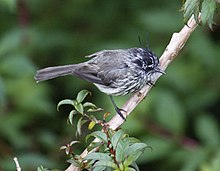Anairetes
| Anairetes | |
|---|---|

| |
| Tufted tit-tyrant (Anairetes parulus) | |
| Scientific classification | |
| Kingdom: | Animalia |
| Phylum: | Chordata |
| Class: | Aves |
| Order: | Passeriformes |
| Family: | Tyrannidae |
| Genus: | Anairetes Reichenbach, 1850 |
| Species | |
|
6, see text | |
Anairetes is a genus containing the tit-tyrants, a group of small, mainly Andean birds, in the tyrant flycatcher family Tyrannidae. The group briefly included the genus Uromyias, which had been recognized based on syringial and plumage characters, including a flatter crest and a longer tail, but was included within Anairetes due to genetic analysis.[1][2] Recent analyses suggested splitting into Uromyias again.[3] Anairetes is believed to be most closely related to the genera Mecocerculus and Serpophaga; however, there is no definitive evidence supporting this claim.[4]
They are fairly small birds (11–14 cm) that get their common name from the tit family, due to their energetic tit-like dispositions and appearance, primarily in their crests.[1] Species in this genus live in temperate or arid scrub habitats and are mainly found in the Andes mountains.[1] It is one of only a few genera of small flycatchers that occur at such high altitudes.[5]
Species[]
The genus contains 6 species:[6]
| Image | Scientific name | Common Name | Distribution |
|---|---|---|---|
| Anairetes alpinus | Ash-breasted tit-tyrant | Bolivia and Peru. | |
 |
Anairetes nigrocristatus | Black-crested tit-tyrant | Ecuador and Peru. |
| Anairetes reguloides | Pied-crested tit-tyrant | coastal Peru and far northern Chile. | |
 |
Anairetes flavirostris | Yellow-billed tit-tyrant | Argentina, Bolivia, Chile, and Peru |
| Anairetes fernandezianus | Juan Fernández tit-tyrant | Juan Fernández Islands in the South Pacific Ocean off Chile. | |
 |
Anairetes parulus | Tufted tit-tyrant | Colombia, Ecuador, Peru, Bolivia, Argentina, and Chile. |
References[]
- ^ a b c del Hoyo 2004, p. 177
- ^ Remsen, J. V., Jr., C. D. Cadena, A. Jaramillo, M. Nores, J. F. Pacheco, M. B. Robbins, T. S. Schulenberg, F. G. Stiles, D. F. Stotz, & K. J. Zimmer. 2007. A classification of the bird species of South America. Archived 2009-03-02 at the Wayback Machine American Ornithologists' Union. Accessed 12 December 2007.
- ^ DuBay, S.G., Witt, C.C. 2012. An improved phylogeny of the Andean tit-tyrants (Aves, Tyrannidae): More characters trump sophisticated analyses. Molecular Phylogenetics and Evolution 64, 285-296.
- ^ del Hoyo 2004, p. 176
- ^ del Hoyo 2004, p. 190
- ^ Gill, Frank; Donsker, David, eds. (2019). "Tyrant flycatchers". World Bird List Version 9.2. International Ornithologists' Union. Retrieved 27 June 2019.
Cited texts[]
- del Hoyo, Josep; Elliott, Andrew; Christie, David, eds. (2004). Handbook of the Birds of the World. Vol. 9. Cotingas to Pipits and Wagtails. Barcelona: Lynx Editions.
{{cite encyclopedia}}: Missing or empty|title=(help)
See also[]
- Tit-tyrants
- Anairetes
- Bird genera
- Taxa named by Ludwig Reichenbach
- Tyrant flycatcher stubs